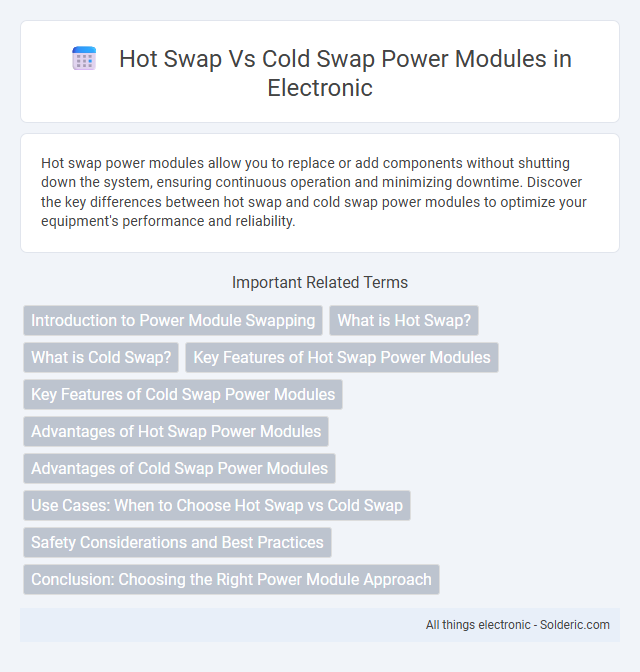Hot swap power modules allow you to replace or add components without shutting down the system, ensuring continuous operation and minimizing downtime. Discover the key differences between hot swap and cold swap power modules to optimize your equipment's performance and reliability.
Comparison Table
| Feature | Hot Swap Power Modules | Cold Swap Power Modules |
|---|---|---|
| Description | Allows replacement without shutting down the system | Requires system shutdown before replacement |
| Downtime | Minimal to none | Significant downtime |
| System Availability | High availability maintained | Availability compromised during swap |
| Complexity | More complex circuitry and design | Simpler design and implementation |
| Cost | Higher due to advanced features | Lower initial cost |
| Use Case | Critical systems requiring continuous power | Non-critical or budget-sensitive applications |
| Risk | Lower risk of data loss or interruption | Higher risk due to power interruption |
Introduction to Power Module Swapping
Power module swapping involves replacing or upgrading power supply units within electronic systems to maintain or enhance system performance. Hot swap power modules allow replacements without shutting down the system, minimizing downtime and ensuring continuous operation. Cold swap power modules require the system to be powered down before replacement, which is suitable for non-critical applications where safety and system integrity are prioritized.
What is Hot Swap?
Hot swap refers to the ability to replace or add power modules in a system without shutting down the equipment, ensuring continuous operation and minimal downtime. This capability is critical in high-availability environments such as data centers, telecommunications, and industrial automation where power modules need to be maintained or upgraded without interrupting service. Hot swappable power modules incorporate built-in protection mechanisms to prevent electrical faults and ensure safe, seamless transitions during replacements.
What is Cold Swap?
Cold swap refers to the process of replacing or installing power modules while the system is completely powered off, ensuring no electrical current flows during the operation. This method prevents potential damage to the hardware caused by electrical surges or shorts that may occur if the component is swapped while energized. Understanding the difference between cold swap and hot swap power modules helps you maintain system reliability and avoid unintended downtime.
Key Features of Hot Swap Power Modules
Hot swap power modules enable seamless replacement or addition of power supplies without shutting down the system, ensuring continuous operation and minimal downtime. These modules feature built-in circuitry to manage inrush current, maintain power integrity, and support real-time monitoring for fault detection and load balancing. Your system benefits from enhanced reliability and scalability by integrating hot swap power modules into critical applications.
Key Features of Cold Swap Power Modules
Cold swap power modules feature the ability to be inserted or removed while the system remains powered off, reducing the risk of electrical damage and ensuring system stability. These modules typically include built-in protection circuits to prevent inrush current and voltage spikes during the connection process. Their design emphasizes reliability and safety in environments where power interruption is acceptable or preferred.
Advantages of Hot Swap Power Modules
Hot swap power modules enable seamless replacement or installation without shutting down the system, minimizing downtime and maintaining continuous operation. They offer enhanced flexibility for maintenance and upgrades, reducing the risk of data loss or system interruptions. These modules also improve system reliability by allowing faulty units to be replaced instantly, promoting efficient power management in critical environments.
Advantages of Cold Swap Power Modules
Cold swap power modules offer enhanced safety by requiring system shutdown before replacement, minimizing the risk of electrical shock and component damage. These modules reduce the chances of data corruption and ensure system stability during maintenance. Cold swapping simplifies design and lowers costs by eliminating the need for hot-swap circuitry and complex protection mechanisms.
Use Cases: When to Choose Hot Swap vs Cold Swap
Hot swap power modules are ideal for mission-critical systems requiring continuous operation, such as data centers and telecom equipment, where modules can be replaced without shutting down the system. Cold swap power modules suit applications with lower uptime demands or controlled maintenance windows, like consumer electronics and basic industrial machinery, where power-off replacement is acceptable. Selecting hot swap or cold swap depends on the need for uninterrupted power delivery and system availability during maintenance.
Safety Considerations and Best Practices
Hot swap power modules enable you to replace or add components without shutting down the system, reducing downtime but requiring strict adherence to safety protocols to prevent electrical hazards and ensure system stability. Cold swap modules require powering down the device before replacement, minimizing risks from live electrical currents but potentially causing operational interruptions. Always follow manufacturer guidelines, wear appropriate protective gear, and verify system status to maintain safe handling of power modules during any swap.
Conclusion: Choosing the Right Power Module Approach
Selecting the right power module approach depends on your system's operational requirements and downtime tolerance. Hot swap power modules allow you to replace or add power supplies without shutting down the system, ensuring continuous uptime and minimizing disruptions. Cold swap modules, while simpler and often more cost-effective, require powering down the equipment, which may suit less critical applications where brief outages are acceptable.
Hot Swap vs Cold Swap Power Modules Infographic

 solderic.com
solderic.com